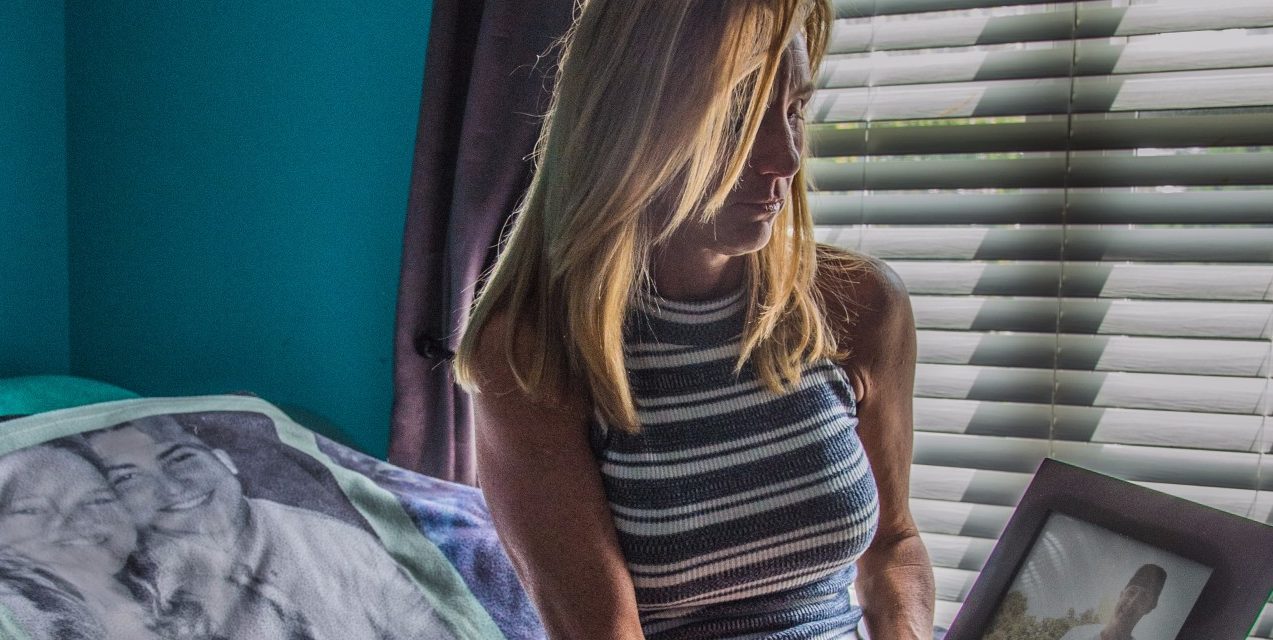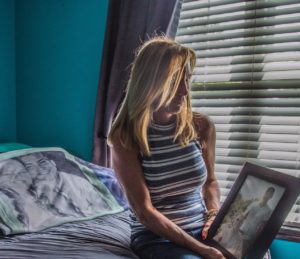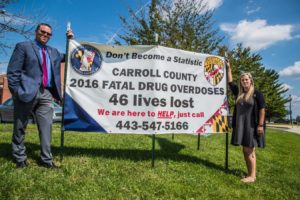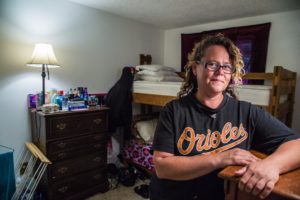by Sylvia Blair, photography by Phil Grout
The state and the nation have been rocked by a growing opioid addiction problem that is also increasing in scope right here in Carroll County. As a result, a coordinated effort to address opioid abuse is galvanizing Carroll County medical providers, caregivers, elected officials, criminal justice and legal experts, first responders and others in a concerted effort to save lives.
“The opioid epidemic is broad in scope because it affects families and individuals from all socioeconomic levels. Much work is being done to address the epidemic, including resource allocation, education, prevention, treatment, and enforcement. Carroll County’s responsible organizations are working collaboratively and closely together for change,” said Delegate Susan Krebs.
Earlier this year, Maryland Governor Larry Hogan declared a state of emergency and committed significant additional funding and resources over the next five years to increase enforcement, prevention and treatment services in the state.
In addition, the state of Maryland issued an executive order to establish the Governor’s Inter-Agency Heroin and Opioid Coordinating Council. The council is a Governor’s subcabinet, which consists of the heads of state agencies or their representatives, and other executive branch agencies.
How Serious is the Problem in Carroll County?

Tammy Lofink lost her son Robert three years ago to a heroin overdose. Here is his desk, untouched since he passed away.
Local Behavioral Health Authority for the Carroll County Health Department Sue Doyle, R.N. said, “The executive order states that the rise in the number of heroin and opioid overdose deaths represents an urgent and growing public health threat, cutting across all demographics and geographical settings in the state. It also represents a serious threat to the security and economic well-being of the state.”
“In Carroll County, there are local hotspots in which frequent ‘cluster’ overdoses happen,” Doyle added. “Based on population and death rates from overdoses, Carroll County is the third in overdoses in the state.”
She continued that in January 2017, the Health Department learned about seven local overdoses in one morning, which underscores the magnitude of the problem.
Doyle said that opioids are easy to get because pain pills are easily prescribed and when addiction happens, people often turn to getting their drugs illegally. “The drug cartels are fine-tuning the heroin trade, causing the perfect storm and making the epidemic so much worse,” she said.
Lisa Pollard, LPN, naloxone training director at the Health Department, said that the antidote Naloxone is used to reverse opioid overdose.
“People’s brains have opioid receptors and Naloxone blocks the receptors to allow a reversal of the overdose,” Pollard said. “It lasts 30 to 90 minutes and if there are still opioids in the system, the person may “re-overdose”. Naloxone helps restore breathing and consciousness.
It is available at pharmacies and the Health Department gives it to affected individuals, families, and community members. The health department also offers training about administration to individuals and service providers, said Pollard.
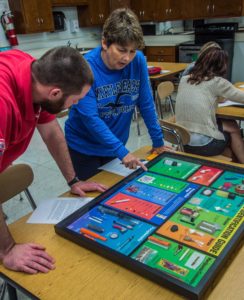
Carroll County middle school health teachers Luke Meinecke and Stacie Stouffer work with a drug education teaching aid as they prepare for the new school year and the task of educating their students on the dangers of drug use.
The emergency department at Carroll Hospital Center is seeing an increase in the number and severity of overdoses locally. Dr. Mark Goldstein, M.D. is chief of Emergency Medicine at the hospital. He explained that opioids primarily derive from or are related to opium. Heroin, synthetic oxycodone and fentanyl are some of the commonly abused opioids.
“Many drugs in this class are used for pain management and are effective at blocking pain pathways,” he said. “The problem is that those drugs are addictive. They produce euphoria initially, and over time, people can become psychologically and chemically dependent on these substances.”
Goldstein said that the problem has been growing. He has noticed a peak in patients presenting to the emergency department with acute overdoses.
“When patients overdose on opioids, they are usually not fully-conscious and can go into fatal respiratory depression. Naloxone (Narcan) can be used as the antidote which reverses these dangerous symptoms. When individuals arrive by ambulance after being initially treated with Naloxone by EMS workers, they are usually awake and alert on arrival, which increases their chances of a better outcome.”
“The next step after treatment in the emergency department, is to connect patients with local addiction treatment resources upon discharge. After becoming medically stable in the emergency department, the patient is offered a consultation with the on-call clinical social worker who shares these resources. We also have Naloxone kits that we can send home with a patient. The kits include the actual Naloxone drug, community treatment resources, and additional information on how to manage an acute overdose,” said Goldstein.
The Community Gathers Together in the Fight Against the Epidemic
An inaugural event held in August illustrates the agency coordination involved in addressing the opioid epidemic. A “First Responders Appreciation Dinner” was hosted by the Carroll County Opioid Prevention Coalition and was sponsored by the Opioid Misuse Prevention Program grant.
Community leaders who attended the event included Carroll County Sheriff Jim De Wees. “First responders face acute issues when individuals overdose, necessitating a response from law enforcement or EMS. In addition, there can be a community domino effect. For example, we may see residual crime in the area,” he said.
Ed Singer, the health officer for the Carroll County Health Department, has noticed that children are watching their parents deal with addiction at an alarming rate.
“Some children are essentially living in homes where both parents are abusing opioids and this may seem normal to those children. It is a hard cycle for families to break through.”
Speakers at the dinner included overdose survivors who wholeheartedly thanked the first responders in attendance for working to save lives.
Jesse, now in recovery said, “Today is my 30th birthday. If it were not for first responders, I would not be standing on this stage tonight. I grew up in a middle-class background in Carroll County. I took Percocet for a sports injury and went down a dangerous road. Now I am in recovery, I hold a job and I serve as a productive member of society.”
Rachael said she was raised in a loving family, and was physically active growing up. She said she became a heroin addict after being prescribed morphine following major surgery. She also began to drink alcohol heavily and said she eventually switched to taking heroin.
“One day I overdosed. Fortunately, 911 was called. Thanks to a 12-step program, I am now living a sober lifestyle. I thank our first responders who demonstrate care, compassion, devotion, bravery and heart and soul,” she said.
Yolanda said she is a mother of an opium addict. Life-saving treatment allowed her son to recover from an overdose. “I am thankful that first responders carry Naloxone and I am so glad that my son is now alive and healthy,” she said.
Awareness, Prevention and Education in the Community
Christine Tobias is assistant supervisor of Health K-12 in the Department of Curriculum and Instructional Resources at Carroll County Public Schools. The curriculum in elementary schools includes information about medications and “refusal skills,” in response to exposure to risky or dangerous behaviors.
Information about the differences between over-the-counter drugs and prescription drugs is also part of the curriculum. General medication instruction is continued in sixth and seventh grades.
“In the eighth grade, we provide instruction on the stages of dependency and the effects of heroin use, including instruction on the treatment of addictive behaviors,” said Tobias.
In high school Health 1, instruction about the effects of prescription and over-the counter drugs emphasize refusing opioids for minor injuries. Students examine the relationship between prescribed opioids and opioid addiction and/or drug overdose.
“Students analyze, influence and examine the consequences of using/abusing drugs, by recognizing the signs and symptoms of drug misuse/abuse and accessing information and services for the treatment of addictive behaviors,” said Tobias.
“Health 2 and 3 are elective classes,” she said. “Students present health fair projects that can be based upon a variety of topics that they are interested in researching. Some students choose to research and to develop a project based on drug awareness.”
The school system has received a grant from the Governor’s office to support community and health education about drug use, according to Tobias. The school system also partners with Linda Auerback, substance abuse prevention supervisor at the health department, to develop educational initiatives. The State’s Attorneys Office of Brian DeLeonardo and the local Chamber of Commerce are also partners.
“This epidemic is a community problem and we all need to work together,” said Tobias. “We are fortunate to have a well- developed curriculum on the topics of opioid education and prevention in Carroll County.”
The Perspective of Youth in the Community
Seventeen-year-old Connor Taylor attends Westminster High School. He participated in the American Legion Boys State, which is among the most respected and selective educational programs of government instruction for high school students. McDaniel College was the local site for the program this year.
Taylor wrote a lengthy and thoughtful essay about the local opioid epidemic. “The essay I wrote was part of the graduation requirements for Boys State,” he said. “My understanding of the opioid epidemic is this: In 2017, President Trump declared the epidemic to be a national emergency. As I wrote my essay, I learned that there were seven overdoses one morning in Carroll County, which led the Carroll County Health Department to release a “community overdose alert.”
“We had classroom lectures about the opioid epidemic in Carroll County and at the national level. This is the reason for writing my essay on the drug problems in Carroll County,” he said.
“Recently my family became a foster home. Many of the children in the program come from homes where drug use is a problem, so I have seen the opioid problem that Carroll County has firsthand,” said Taylor. “As I wrote my essay, I felt that many of the drug problems in my hometown of Westminster and in all of Carroll County result from the lack of things for people my age to do. I believe that a community center would help by giving youth a safe place to hang out and provide activities”.
Tammy’s Story
Tammy Lofink is president and co-founder of Rising Above Addiction. After her 18-year-old son Robert passed away in 2014 from a heroin overdose, she sought to keep his memory alive and to honor him with a meaningful endeavor. On the first anniversary of his death in 2015, Lofink opened Rising Above Addiction.
“I want to help others deal with the same pain that my family faces while they try to help loved ones to start treatment in a timely manner,” said Lofink. “I also want to help people become aware of the opioid epidemic in a novel way that exemplifies thinking outside of the box,” she said.
“Rising Above Addiction organizes community fundraising events like skydiving, annual runs, and rock climbing that encourage healthy activity and which raise funds to help fund treatment. Funds raised support rapid assistance by finding facility openings, which can defuse crises. Rising Above Addiction helps to connect people in need. If they have no insurance, we help pay for their treatment. This is a bittersweet labor of love for our family,” said Lofink.
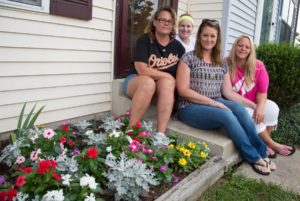
Members of the sober house “Reclaiming My Life” in Westminster are Crystal Smith (left), Lindsay Harrison, Anjeanette Cruz and Sara Hipsley (house manager). A project of Tammy Lofink’s “Rising Above Addiction.”
Lofink believes that people can become addicted to opioids because they may underestimate their potency and falsely believe that drugs from drug dealers are actually labeled truthfully. “Once a person runs out of their pain prescription, it is easy to approach a drug dealer, who is lacing drugs and profiting from the transactions. It is hard to stay in front of this epidemic, but I firmly believe that Carroll County is on the cutting-edge as we see more people reaching out for help before it is too late,” said Lofink.
Recently, “Reclaiming My Life” sober house opened in Westminster, which is a program that Lofink helped to get started. Eight women in recovery share a house, including a manager. The house provides a safe environment for recovery and for learning accountability.
Forty-one-year old Crystal Smith is a resident. She said the house is important to her because it offers a clean and sober living area to help her accomplish her personal goals. “I want to become a better and more independent person, and I want to keep it that way,” she said.
Forty-five-year-old Sara Hipsley, a resident in recovery, said she is learning more about carrying out her responsibilities and that she feels supported at the sober house.
For more information on Rising Above Addiction please contact Tammy Lofink at 410-995-8076 or email tammylofink@gmail.com
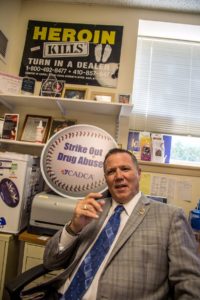
Tim Weber, drug education and treatment liaison for the Carroll County State’s Attorney’s office, has turned his life around from drug addiction to drug education.
Tim’s Story
Tim Weber is the drug treatment and education liaison for the Carroll County State’s Attorney’s Office. He works hard to support people in recovery, because Weber himself is in recovery. He knows the challenges first-hand.
“I grew up in a well-adjusted family. I played lacrosse and was an amateur boxer. I was not the kid you would have thought would end up leaving high school, experimenting with hard drugs, and wind up robbing and stealing in Baltimore City,” said Weber.
“In October 2003, I overdosed for the last time on Washington Boulevard and Ostend Street. I was revived with two doses of Naloxone. Shortly after that, I entered Howard County General Hospital and stayed there for three days, moving later into a sober living house in Baltimore,” he said.
From that time on, Weber slowly started to turn his life around. He started to follow a 12-step model of recovery. He said he learned early-on that the way to stay grounded in recovery was to help others. “That is what I started doing from day one of recovery. Later, I opened a couple of sober houses for others in recovery. I continued this work until I started working for the State’s Attorney’s Office.”
Since July of 2015, Weber has worked directly with law enforcement and first responders to assist addicted persons after a non-fatal overdose and engages them to enter treatment.
“I literally get calls and emails every day about overdosed individuals who desperately need to get into treatment. I see the faces of those people, not just the numbers. On the prevention side, I put together two school programs. One is called the “Special OPTS” program (Opiate Prevention and Teen Support) for juniors and seniors in the public school system. The other is called “Don’t Believe the Lie,” a program for eighth grade students in the county. I also am trained to teach others to administer Naloxone.”
Help and Hope in the Community
The Community Foundation of Carroll County, Inc. has $6.4 million under management on behalf of over 280 different funds, said Executive Director Audrey Cimino. “You cannot separate the ‘opioid crisis’ from alcohol, drug and other addictions, as well as from certain mental health issues. They are all fingers on the same hand,” she said.
“You cannot ignore the over-use of pain medication and the fact that people resort to street drugs when the prescription is no longer available. About ten years ago we started seeing scholarships being set up when a young person overdosed or a 10-year-old, clinically-depressed boy committed suicide. That kind of fund is still established,” she said.
“We took on a support fund for Carroll County Adult Drug Treatment Court Program a few years ago. Now we have several funds that support the efforts of donors to get persons with addiction off the street and into recovery. We have several housing projects for those in recovery as well as ecumenical faith-based groups that provide food, clothing and comfort,” Cimino said.
Dawn Brown, M.S., is director of Quality Improvement and Prevention at the health department. Brown cites an impressive number of local organizations and agencies that are working hard to address the opioid epidemic. “Those organizations, which are so dedicated, include Access Carroll, the Health Department, the Carroll County State’s Attorney’s Office, Carroll Hospital Center, Carroll County Public Schools, Foolproof improvisational theatre group, local law enforcement, recovery agencies and the Partnership for a Healthier Carroll County,” she said.
The following local organizations provide help and hope:
- Triangle Recovery
Phone: 410- 861-6083
Email: trianglerecoveryclub@comcast.net - Catherine’s Cause
Cindy and Phil Mullikin
Phone: 410-239-8371 - Rising Above Addiction
Tammy Lofink
Phone: 410-995-8076
Email: tammylofink@gmail.com - Anthony’s Way
Gina DeMaria
Phone: 443-613- 7621
Email: anthonysway22@gmail.com - Sober Truth
Joyce Mahoney, Ph.D., M.S.W.
Phone: 443- 858- 5036
Email: sobertruth1@comcast.net - Foolproof
Paul Zimmerman
Phone: 443-340- 7005 - Firestorm Theatre Troop
Michele Field
Phone: 443-604-3291
Email: mfield.firestorm@gmail.com - Paddd (Positive Alternatives to Dangerous and Destructive Decisions)
Debbie Yohn
Phone: 410-530-7455
Email: Paddd@comcast.net - Addiction and Art
Margaret Dowell
Phone: 301-639-3520
Email: mdowellart@aol.com

